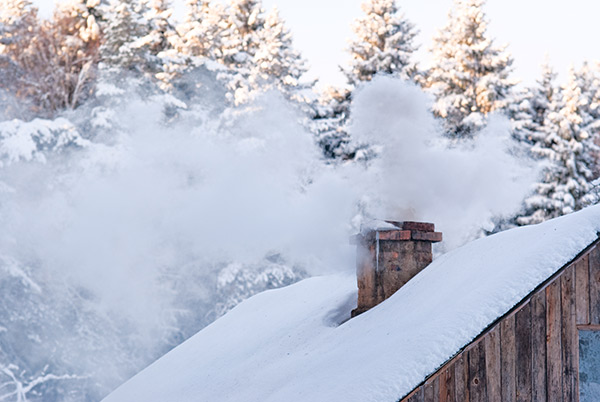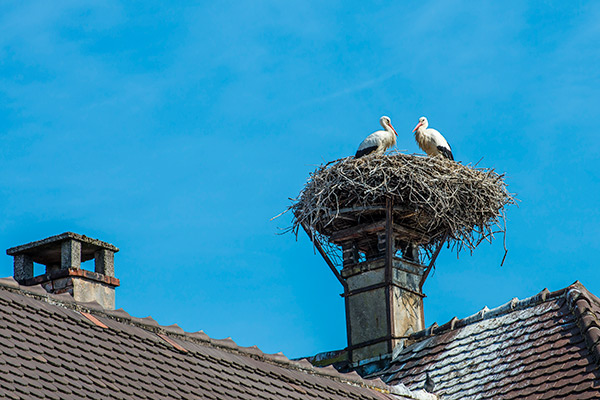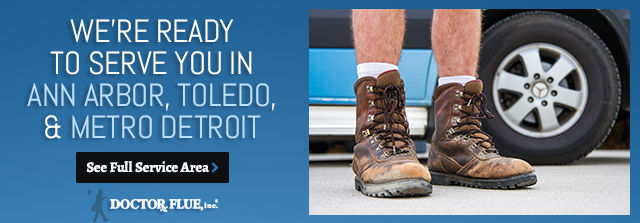
There’s nothing better than a roaring fire to fight away the winter chill. But while your fireplace is keeping you warm, it’s struggling against the cold too! Frigid weather is tough on masonry, which means you may end up with a cracked chimney – or worse. When you’re done enjoying the comfort of your fire, make sure to keep your eyes open for potential signs of winter chimney damage.
Moisture Damage
Your masonry is constantly under assault from moisture. Throughout the entire year, rain and humidity introduce moisture to your chimney – both on the exterior and the interior. Moisture that seeps through the porous bricks, slowly erodes them over time.
During the winter season, this moisture can be exceptionally harsh on your chimney. In addition to moisture from snow and rain, frigid temperatures can cause the trapped water to freeze inside of the bricks.
When water freezes, it expands, which leads to a cracked chimney. As the chilly season continues, these cracks happen more frequently. Just one rough winter can cause significant damage to the masonry of your chimney.
The effects of a cracked chimney aren’t just cosmetic issues. Depending on the state of your flue liner, cracks in the brick can interrupt the proper airflow of your chimney. In some cases, this may not be noticeable, but in severe cases, it can be a potential precursor to a chimney fire.
Extreme winters can cause catastrophic damage to your chimney – ultimately leading to a collapse. Many homeowners understand to watch for issues like frozen pipes, but it’s equally as important to keep an eye on your chimney and fireplace when temperatures consistently drop below the freezing point.
The Stack Effect
A fireplace can make it easier to stay warm when winter kicks into full-gear. But that cold weather can make it more difficult for your fireplace to work. A significant difference in temperature between your home and outdoors creates a density difference. This forces cold air outside to move through your chimney and into your home.
Not only does this type of draft lower your home temperature and potentially increase your heating bills, it can prevent your fireplace from functioning correctly. A strong Stack Effect will create such a strong draft that you won’t be able to start a fire at all. In less severe cases, it can force smoke from a fire back into your home or lead to poor ventilation that might increase your risks of carbon monoxide poisoning.
Animal Shelter
The cold weather doesn’t only invite snow and smoke into your home. A variety of animals in your neighborhood will be desperately searching for ways to stay out of the cold – and your chimney is a direct entrance to shelter. We’ve seen all types of critters, from small mammals to birds to even raccoons.

Animals in your chimney are more than just nuisance. There are risks involved, for both the animal and your home. Chimneys aren’t designed for travel, so it’s common for larger critters to trap themselves inside. Even if they don’t become trapped, nesting animals can leave your chimney blocked with debris. In minor cases, this can simply impact the airflow of your exhaust. However, serious cases can lead to complete failure of the flue system as well as dangerous carbon monoxide buildup.
How You Can Prevent Cracked Chimneys & Winter Damage
Install a Top-Sealing Damper
One of the best ways to keep moisture out of your chimney is to invest in a top-sealing damper. These specialized dampers have a rubber gasket seal that forms an airtight protection against the outside when closed.
During snowy or rainy seasons, a top-sealing damper will prevent any precipitation from sneaking in through the mouth of your chimney. Like any moisture damage, the best way to avoid it is to keep your chimney dry.
Top-sealing dampers do much more than prevent water damage, too! Due to the airtight seal they create, critters and debris won’t be able to enter your chimney either. This will help keep your chimney safe for operation between your annual chimney cleanings.
Because they prevent downdrafts, they also increase the efficiency of your fireplace. They’re one of our most recommended chimney parts for going green! You’ll stay warmer and pay even less when using your fireplace.
Replace Your Chimney Liner
If you’re not familiar with the inner workings of your chimney, you may not realize that there’s a flue liner inside the masonry. This chimney liner protects your bricks from everything like, moisture and the corrosive by-products created by combustion.
Older homes sometimes have clay tile liners that have become cracked and damaged over time. Damaged chimney liners allow damaging substances to reach the interior brick where they can wreak havoc.
Not sure if your chimney liner needs to be replaced? Schedule an inspection from Doctor Flue, we can identify issues and recommend if a chimney liner replacement is necessary for your home.
Replace Your Chimney Cap
An uncapped chimney is like leaving your front door wide open. It exposes your home to the elements and invites unwanted guests in at their leisure. Like a top-sealing damper, a chimney cap prevents rain, snow, debris and animals from entering your flue through the top of your chimney.
Every chimney needs some sort of cap. More importantly, these chimney caps need to be regularly inspected. Over time, rust and weathering can damage a chimney cap and create breaches in its defense. A hole in your chimney cap means it can’t protect your chimney any longer.
It’s a good idea to occasionally take a close look at your chimney cap, even if you can only look from the ground level. However, damage can be difficult to spot for the untrained eye – especially from afar. Leave it to the experts to inspect your chimney cap.
Prevent Winter Chimney Damage – Call Doctor Flue!
If your chimney hasn’t been inspected or cleaned this year, contact us today! Doctor Flue offers chimney services in Michigan and Ohio and can inspect your chimney and identify any potential risks. We’ll get you set up right away so you can have peace of mind.
Call Us: 1-800-438-3583
Email Us: office@drflue.com
Office Hours: Mon-Fri: 8am-4pm
Connect with Doctor Flue on Social Media

